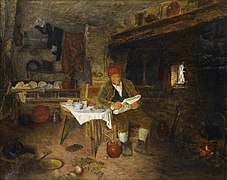
Victorian era
In the history of the United Kingdom and the British Empire, the Victorian era was the reign of Queen Victoria, from 20 June 1837 until her death on 22 January 1901. Slightly different definitions are sometimes used. The era followed the Georgian era and preceded the Edwardian era, and its later half overlaps with the first part of the Belle Époque era of continental Europe.
Various liberalising political reforms took place in the UK, including expanding the electoral franchise. The Great Famine caused mass death in Ireland early in the period. The British Empire had relatively peaceful relations with the other great powers. It participated in various military conflicts mainly against minor powers. The British Empire expanded during this period and was the predominant power in the world.
Victorian society valued a high standard of personal conduct across all sections of society. The emphasis on morality gave impetus to social reform but also placed restrictions on certain groups' liberty. Prosperity rose during the period, but debilitating undernutrition persisted. Literacy and childhood education became near universal in Great Britain for the first time. Whilst some attempts were made to improve living conditions, slum housing and disease remained a severe problem.
The period saw significant scientific and technological development. Britain was advanced in industry and engineering in particular, but somewhat undeveloped in art and education. Great Britain's population increased rapidly, while Ireland's fell sharply.
19th-century Britain saw a huge population increase accompanied by rapid urbanisation stimulated by the Industrial Revolution.[79] In the 1901 census, more than three out of every four people were classified as living in an urban area, compared to one in five a century earlier.[80] Historian Richard A. Soloway wrote that "Great Britain had become the most urbanized country in the West."[81] The rapid growth in the urban population included the new industrial and manufacturing cities, as well as service centres such as Edinburgh and London.[80][82] Private renting from housing landlords was the dominant tenure. P. Kemp says this was usually of advantage to tenants.[83] Overcrowding was a major problem with seven or eight people frequently sleeping in a single room. Until at least the 1880s, sanitation was inadequate in areas such as water supply and disposal of sewage. This all had a negative effect on health, especially that of the impoverished young. For instance, of the babies born in Liverpool in 1851, only 45 per cent survived to age 20.[84] Conditions were particularly bad in London, where the population rose sharply and poorly maintained, overcrowded dwellings became slum housing. Kellow Chesney wrote of the situation:[85]
Hunger and poor diet was a common aspect of life across the UK in the Victorian period, especially in the 1840s, but the mass starvation seen in the Great Famine in Ireland was unique.[86][84] Levels of poverty fell significantly during the 19th century from as much as two thirds of the population in 1800 to less than a third by 1901. However, 1890s studies suggested that almost 10% of the urban population lived in a state of desperation lacking the food necessary to maintain basic physical functions. Attitudes towards the poor were often unsympathetic and they were frequently blamed for their situation. In that spirit, the Poor Law Amendment Act 1834 had been deliberately designed to punish them and would remain the basis for welfare provision into the 20th century. While many people were prone to vices, not least alcoholism, historian Bernard A. Cook argues that the main reason for 19th century poverty was that typical wages for much of the population were simply too low. Barely enough to provide a subsistence living in good times, let alone save up for bad.[84]
Improvements were made over time to housing along with the management of sewage and water eventually giving the UK the most advanced system of public health protection anywhere in the world.[87] The quality and safety of household lighting improved over the period with oil lamps becoming the norm in the early 1860s, gas lighting in the 1890s and electric lights beginning to appear in the homes of the richest by the end of the period.[88] Medicine advanced rapidly during the 19th century and germ theory was developed for the first time. Doctors became more specialised and the number of hospitals grew.[87] The overall number of deaths fell by about 20%. The life expectancy of women increased from around 42 to 55 and 40 to 56 for men.[note 6][81] In spite of this, the mortality rate fell only marginally, from 20.8 per thousand in 1850 to 18.2 by the end of the century. Urbanisation aided the spread of diseases and squalid living conditions in many places exacerbated the problem.[87] The population of England, Scotland and Wales grew rapidly during the 19th century.[89] Various factors are considered contributary to this, including a rising fertility rate (though it was falling by the end of the period),[81] the lack of a catastrophic pandemic or famine in the island of Great Britain during the 19th century for the first time in history,[90] improved nutrition,[90] and a lower overall mortality rate.[90] Ireland's population shrank significantly, mostly due to emigration and the Great Famine.[91]




![Buildings originally built as Llanfyllin workhouse, a state-funded home for the destitute which operated from 1838 to 1930.[92][93]](http://upload.wikimedia.org/wikipedia/commons/thumb/6/67/Llanfyllin_Workhouse_-_geograph.org.uk_-_3098623.jpg/400px-Llanfyllin_Workhouse_-_geograph.org.uk_-_3098623.jpg)
